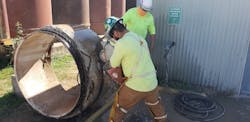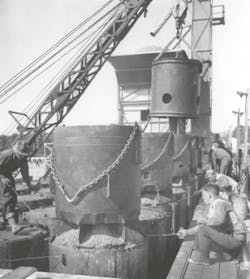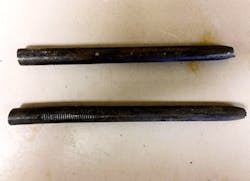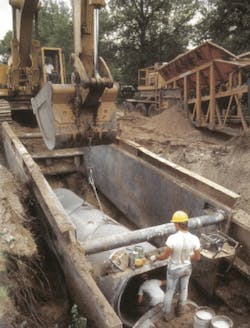8 Decades of Service for a Cross-Country Concrete Pressure Pipe
Kevin Baas, P.E. is senior technical resource manager for Thompson Pipe Group. Baas can be reached at [email protected]. Darren W. Dunker, P.E. is national engineering manager for Thompson Pipe Group. Dunker can be reached at [email protected].
undefinedIn 1940 one of the most historic events in the water industry took place in Grand Rapids, Michigan, when Price Brothers Company completed installation of the first cross-country pipeline from Lake Michigan into the city. Noted as one of the largest public works projects of that era, the 31-mile pipeline included 10,000 sections of 46-inch concrete pressure pipe. Eighty years after installation Thompson Pipe Group tested a pipe section and deemed it fit for continued service. In addition to the exciting opportunity to test a pipe in operation for eight decades, the project had special meaning. Price Brothers Company has historical ties to Thompson Pipe Group employees and facilities.
Why Concrete Pressure Pipe?
In the mid-1930s the City of Grand Rapids engineers determined Lake Michigan water was better quality and more economical to treat than Grand River. With money from the Public Works Administration, the city commissioned the design of a new pressure pipeline. At the time cast iron and steel were the accepted as popular pressure pipe options. Engineers were skeptical of concrete; it was new and unproven.
However, that did not stop Harry Price, Jr., the Price Brothers Company founder’s son, from promoting the benefits of built-in corrosion protection, versatility, strength and economical cost. He convinced city engineers to include concrete pipe in the bid. Price’s bid was 10% lower than the competitors. In 1939 a manufacturing plant was relocated to west of Grand Rapids. One year later Price Brothers Company completed the installation. The pipeline was expected to meet the city’s water demands for 50 years.
Modern-Day Testing
In 2019, city engineers were curious about the physical properties of the pipe. With none of the original designs available, the city approached engineering consultants to determine the capacity of the pipe. The consultants enlisted Thompson Pipe Group, an engineered products manufacturer and employer of pipe design experts, to help determine the structural capacity of the pipeline.
Thompson Pipe Group quality team members dissected the pipe to obtain samples of concrete, cylinder steel, and reinforcing rod. These samples were mechanically tested to determine material properties of the components. Using the test results and the pipe configuration, the Thompson Pipe Group engineering department reverse engineered the design. The consultants and the owner received detailed information about the material properties and capacity of the section tested.
Benefits of Concrete Pressure Pipe
The corrosion benefits of steel encased in concrete in a subterranean environment yield a potentially limitless lifespan. Taking advantage of the strengths of both concrete and steel it provides a high strength economical design. The benefits of concrete pressure pipe are as timeless today as they were 80 years ago.
Economical Ease of Installation
A rigid conduit, concrete pressure pipe requires no special bedding or backfill under normal ground conditions. Installing any other pipe material often requires bracing, highly compacted bedding, trucking in aggregate, each adds cost, time and potential problems.
High Pressure Capacity
Concrete pressure pipe has the high strength to withstand internal and external loads. The concrete and steel wall is prestressed with high-strength steel wire to provide more-than-sufficient strength to withstand the pressure requirements. The rigid wall fully supports the external forces of the surrounding earth. Prestressed concrete cylinder pressure pipe is the only piping material that is designed for the combined application of internal pressure and external load.
Corrosion Protection
Concrete pressure pipe provides built-in corrosion protection. The high pH, alkaline environment provided by the portland cement concrete and mortar provides electrochemical protection against corrosion for the encased steel components. This offers strong barrier-type protection compared to polyethylene encasements, tape wraps and paint.
Design Customization
Concrete pressure pipe is a composite engineered product which is custom-designed for each application; thus, the pipe can be designed to most efficiently provide a solution meeting the needs of the customer. Each section of pipe, along with the fittings, are designed and fabricated to meet project-specific internal pressures and external loadings.
A Second Cross-Country Pipeline
In the late 1980s, after nearly five decades of reliable service, city engineers researched the line and predicted it would last another 50 years. To meet increased water demand, the city commissioned a 60-inch parallel pipeline.
Based on the excellent service of the original water line, the city again chose concrete pressure pipe, but this time it selected prestressed concrete cylinder pipe (PCCP). Developed shortly after the original project was installed, today’s PCCP takes these benefits even farther. Specifically, the PCCP prestressing wire produces a more efficient, high capacity pipe design than possible with C300.
Two Types of PCCP
Line Cylinder Pipe (LCP)
First used in North America in 1942, LCP consists of a welded steel cylinder with steel joint rings at each end, an internal concrete lining, high-tensile strength steel wire wrapped directly on the steel cylinder and an external coating of portland cement mortar. LCP is generally used for smaller pipe diameters, 16 to 48 inches.
Embedded Cylinder Pipe (ECP)
ECP consists of a welded steel cylinder with steel joint rings at each end. It is embedded in a vertically cast concrete core with high-tensile strength steel wire wrapped on the exterior concrete core surface and an external coating of portland cement mortar. First installed in North America in 1953, ECP is typically installed in 54- to 144-inch diameter pipe. This second cross-country pipeline included 32.5 miles of 60-inch ECP and 42-inch LCP.
Joint Protection
To ensure longevity Thompson Pipe Group manufactures joints with three layers of protection. Unlike the pipe itself, in which steel components are encased in protective concrete or mortar during manufacturing, sealing portions of the steel joint rings are not encased. To protect these steel components, Thompson Pipe Group incorporated three layers of exterior protection: zinc metallized coating, cement mortar and grout, and typar and ethafoam.
Zinc Metallized Coating
The use of zinc metallized rings provides corrosion protection for the steel joint rings and eliminates the need to mortar point the interior joints on water and treated wastewater lines. Zinc metalizing provides corrosion protection for the steel in two ways: as a barrier and through galvanic action.
Cement Mortar & Grout
During installation, the exterior portions of the joints are covered in portland cement grout. The primary function is to protect exposed steel components of the joint. Portland cement grout provides electrochemical protection. When steel is encased in a highly alkaline environment like grout, with high pH between 12.5 and 13.5, the surface of the steel is passivated and will not oxidize.
Typar & Ethafoam
Concrete pressure pipe comes with two-ply diapers that consist of a Typar synthetic fabric layer with a 0.25-inch closed-cell foam Typar lining, which provides an additional layer of protection. This combination of Typar and Ethafoam creates a barrier between the joint rings and corrosive material in the soil or groundwater.
Joint Testing Options
Testable joints are leak free and allow zero infiltration. Contractors can air test joints in the field at the time of installation and confirm leak-free joints.
Restrained Joint Options
Snap Rings
Mechanical restrained joints are easy to install. In the 1970s Price Brothers Company began manufacturing pipe with Snap Rings. Today Thompson Pipe Group is the only manufacturer of this one-bolt tightening system used to restrain 16 to 60-inch diameter pipe. The time-tested installation method has several advantages:
- The joint is assembled at the plant, meaning the joint arrives at the trench self-contained and ready to lay. There are no separate pieces.
- Contractors need only tighten a 3/8-inch bolt and fill the joint diaper with mortar.
- No welding is required and there is no need to track down welders in a scarce labor market.
- There are financial savings due to efficient installation.
- The joint is ideal for wet conditions.
Clamp Joint
In addition to the Snap Ring restrained joint, Thompson Pipe Group offers a harness clamp joint. This joint provides restraint for prestressed pipe diameters 66 inches and larger and for bar-wrapped pipe 54 inches and larger. This joint is restrained by a two-part harness clamp. The bottom half of the harness clamp is positioned under the joint prior to placing the next pipe length.
After the pipe is installed, the top half of the clamp is positioned over the joint and secured to the bottom half by tightening bolts on each side. Prior to pressurizing the line, portland cement grout is poured into a grout band encapsulating the joint. The portland cement grout distributes any thrust loads around the joint as well as providing corrosion protection for the joint.
Time Tested Pipe Technology
In 1989, at the groundbreaking of the second concrete pressure pipeline from Lake Michigan, 79 year-old Harry Price, Jr., joked that he would make himself available for the installation of a third line in another 50 years. In solidarity Thompson Pipe Group engineers offer the same proposition.



